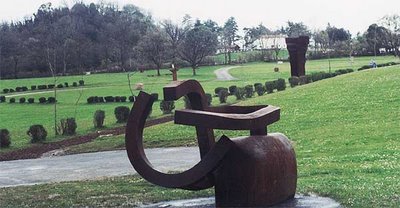Chillida-Leku
 An article by Stephen Hugh-Jones (An outdoor showcase for Basque sculptor, May 1) in the International Herald Tribune may be of interest (with my added links):
An article by Stephen Hugh-Jones (An outdoor showcase for Basque sculptor, May 1) in the International Herald Tribune may be of interest (with my added links):
It was Frank Gehry's architecture-as-sculpture Guggenheim Museum that put Bilbao on the tourist map. But its contents are seldom of that distinction. For contrast, go 105 kilometers, or 65 miles, east to an open-air sculpture park. It holds more than 40 works by one of the finest sculptors of the 20th century: Eduardo Chillida. Few foreigners, maybe one in five of its 90,000 visitors a year, venture that far. More should.As Hugh-Jones mentions later in the article, there is a retrospective of Chillida's sculpture right now at the Guggenheim Bilbao. Someone who visited Chillida-Leku has put some photos on a Flickr site. This article brought inevitable comparison in my mind to American sculptor David Smith, who just happens to be having a retrospective at the Guggenheim Museum in New York right now (ending on May 14: I will not be able to see it) and who just happens to have installed his own sculptures on his farm near Bolton Landing, N.Y.
Chillida, born in 1924 in nearby San Sebastián, worked above all in forged iron and steel, using massive blocks and twisted rods, often square in cross-section, to create his highly formal, nonfigurative pieces. Some are five or more meters, or 17 feet, high: like one that the hastiest visitor to Bilbao can see, rusting - as it is meant to - outside that city's airport. Most are heavy. "He never made anything hollow," says his son Luis, who runs the sculpture park. "My father thought space was there to be accessible or not at all." One giant in the Chillida-Leku park ("Chillida's place" in Basque) weighs more than 60 tons.
Chillida used other materials as well: granite, notably, but also concrete, alabaster, terra cotta and - briefly in the 1950s - wood. But iron was a natural choice. Spain's metalworking industries were built on the ore of the Basque Country, where Chillida lived nearly all his life until his death in 2002. And when he returned in 1950 from two years' study in Paris to marry, the newlyweds' house in Hernani, a village outside San Sebastián, was near the local forge. Chillida got the blacksmith to teach him the craft of ironwork. One day the smith decided Chillida was distracting his other apprentices from the mundane work they had to do to make a living. "You use the forge at night," he said, "the rest of us during the day." For four years Chillida perfected his art as a solitary night worker.




















































No comments:
Post a Comment